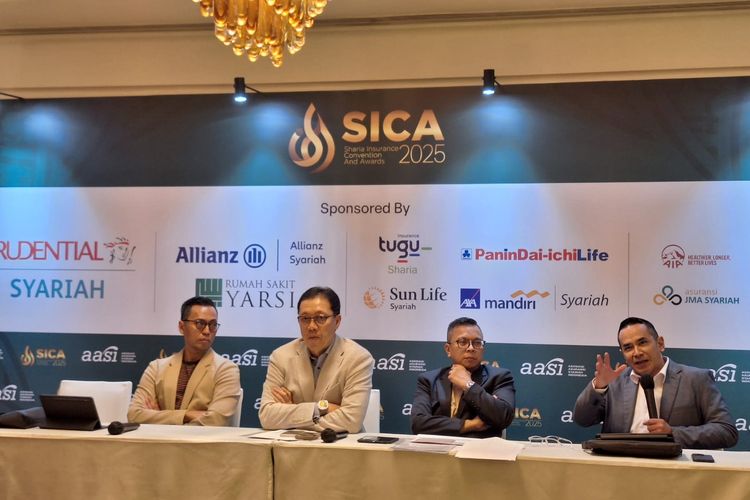Liga Asuransi – The Indonesian insurance industry is currently facing complex dynamics. These include the “Rojali-Rohana” phenomenon, reflecting changing consumer behavior, premium reductions in certain segments, and strengthening regulations and oversight by the Financial Services Authority (OJK). Meanwhile, product innovation, marketing strategies, and the achievements of several companies demonstrate that this sector still holds significant potential for growth. The following series of recent news stories summarizes key issues influencing the direction of the national insurance industry’s development.
This is Why the Insurance Association Supports the Scheme Co-payment Which Keeps Premiums Low
The Indonesian Sharia Insurance Association (AASI) highlighted the importance of communication regarding risk sharing schemes or co-payment in health insurance products. Secretary and Head of the Legal, Compliance, and Inter-Institutional Division of AASI, R. Arry Bagoes Wibowo, emphasized that the scheme co-payment Sharia insurance is no different from conventional insurance. According to him, the most important thing is how to communicate it to the public.
Arry Bagoes explained that the assumption that co-payment This burden on consumers needs to be addressed. In fact, this scheme serves as a safeguard for policyholders, preventing them from facing excessive annual premium increases.
The rise in health insurance claims, which has implications for premium increases, is due to several factors. Two of these are medical inflation and the alleged over treatment from the hospital. If there is no scheme co-payment, premium costs can continue to rise until they reach a point that is burdensome for consumers.
“Every year, the price of these health products will increase, reaching a point where consumers will think, ‘Oh, this is too expensive,'” Arry explained.
OJK Postpones Regulation Co-payment
As a regulator, the Financial Services Authority (OJK) has postponed the implementation of the schemeco-paymenton commercial health insurance products. This policy was previously outlined in OJK Circular Letter No. 7 of 2025. The postponement was decided at a Working Meeting of Commission XI of the House of Representatives (DPR) with the Chairman of the OJK Board of Commissioners on June 30, 2025.
The Chairman of Commission XI of the House of Representatives, Mukhamad Misbakhun, explained that the postponement was intended to gather input and provide a stronger legal basis. “In the context of drafting the OJK Regulation (POJK), the OJK is postponing the implementation of OJK Circular Letter No. 7 of 2025 until the POJK is enacted,” Misbakhun said.
AASI stated that it will support and comply with the relevant regulations.co-paymentwhich will later be issued by the regulator. This postponement allows all parties time to refine the regulations and conduct more effective public outreach.
Life Insurance Premiums Are Down! Here Are 5 Effective Ways to Boost Your Income
The Financial Services Authority (OJK) recorded a 0.57% year-on-year (YoY) decline in life insurance premiums as of June 2025, reaching Rp87.48 trillion. This decline is believed to be closely related to weakening consumer purchasing power, which has shifted consumer priorities to insurance products with lower premiums and essential benefits.
According to Abitani Taim, Chairman of the College of Risk Management and Insurance (Stimra), this situation is also exacerbated by the unrecovered investment climate. This has resulted in a decline in sales of life insurance products.unit-linkedwhich was previously a mainstay of the industry.
Abitani stated that the challenges facing the insurance industry today are complex. These range from macroeconomic dynamics, regulatory changes such as PSAK 117 and minimum equity requirements, to medical cost inflation, which has driven up health insurance premiums. Furthermore, the industry also faces constraints related to product limitations, distribution channels, and challenges posed by technological developments.
5 Effective Strategies to Increase Life Insurance Premiums
Facing these challenges, Abitani Taim provides five strategic suggestions for insurance companies:
- Focus on Traditional Products: Returning to traditional insurance products such aswhole life, term life, And endowmentThese products are considered more certain and less affected by market fluctuations, making them more attractive to consumers seeking stability.
- Expand Digital Channels and Technology: Expanding distribution through digital channels and utilizing technologyartificial intelligence (AI)This can speed up the policy acceptance and claims process, creating a more efficient experience for customers.
- Strengthening Partnerships with Banks: Strengthening collaboration with banking through schemesbancassuranceto offer pure protection products or health insurance.
- Improve Public Education: Conducting a more massive educational campaign to increase public awareness about the importance of life protection.
- Target a Specific Market Segment: Creating products that suit market segments and niches (niche market) to reach more specific consumer needs.
These suggestions are expected to help the life insurance industry adapt, grow again, and face the challenges of a dynamic economy.
Astra Insurance’s Outstanding Performance Achieves AM Best’s Top Ranking for 3 Consecutive Years
PT Asuransi Astra Buana (Asuransi Astra) has once again achieved a milestone by maintaining the highest credit rating from global rating agency AM Best. This achievement, achieved for the third consecutive year, was announced on Thursday (August 7, 2025) and is a clear demonstration of its solid financial fundamentals and consistent operational performance.
Astra Insurance has successfully achieved a Financial Strength Rating (FSR) of A- (Excellent) and a Long-Term Issuer Credit Rating (LCR) of “a-” (Excellent). Furthermore, the company also achieved an Indonesian National Scale Rating (NSR) of aaa.ID (Exceptional), all withoutlookstable. AM Best assesses the company’s balance sheet strength as “very strong,” supported by risk-based capitalization (risk-adjusted capitalization) at the “strongest” level as of December 31, 2024.
Efficiency and Solid Growth
Astra Insurance’s operational performance over the past five years (2020–2024) was also assessed as “strong.” This is reflected in the averagecombined ratiowhich reached 87.9% andReturn on Equity(ROE) of 17.4%. In 2024 alone,combined ratiois at 87.2%, indicating efficiencyunderwritingwhich is maintained thanks to the support of the business portfolio from the Astra Group.
Maximiliaan Agatisianus, President Director of Asuransi Astra, stated that this achievement is part of the company’s long-term strategy. “We want to continue growing and developing by improving the quality of our products and services, as well as strengthening customer and stakeholder trust,” he said.
Nevertheless, AM Best noted that the company’s investment risk profile is moderate, with the majority of exposure to domestic bonds and mutual funds. The main challenge highlighted is counterparty credit risk due to exposure to domestic reinsurance that does not yet have an international rating.
Overall, the rating given by AM Best confirms Astra Insurance’s financial resilience and risk management effectiveness amidst uncertain global economic conditions and intense competition in the national insurance industry.
Source: https://wartaekonomi.co.id/read578025/ketahanan-finansial-kuat-asuransi-astra-raih-rating-a
AAJI Fully Supports OJK’s Plan,KPPEExpected to Strengthen the Insurance Industry
The Financial Services Authority (OJK) is currently preparingDraft OJK Circular Letter (SEOJK)related to the grouping of insurance companies based on equity, or what is known asInsurance Company Groups Based on Equity (KPPE)This plan received a positive response from the Indonesian Life Insurance Association (AAJI).
This draft SEOJK will regulate the standardization of business lines for general insurance, sharia general insurance, life insurance, and sharia life insurance products. Companies with smaller equity (KPPE 1) will only be allowed to market products with simple risks and small coverage values. Meanwhile, companies with greater equity (KPPE2) can market all insurance products.
Togar Pasaribu, Executive Director of AAJI, assessed this policy as highly relevant for strengthening capital structures and risk management. He stated that these business activity restrictions are crucial to prevent companies from taking risks disproportionate to their capital. This will ultimately ensure company sustainability and protect policyholders.
Challenges and Solutions for Increasing Equity
Togar acknowledged that the life insurance industry’s access to capital is currently potentially limited, as investors become more selective amid economic uncertainty. Nevertheless, AAJI encourages companies facing equity challenges to pursue mergers or acquisitions.
This step is expected to create a healthier and more competitive industrial climate. Data as of March 2025 shows that 42 life insurance companies have met the minimum capital requirement of IDR 250 billion for 2026. This number is expected to grow, given that there is still about a year left before the deadline.
Financial Services Authority (OJK) Regulation (POJK) Number 23 of 2023 stipulates minimum equity requirements in stages. In the first stage, life insurance companies must have a minimum equity of IDR 250 billion by December 31, 2026. Subsequently, by December 31, 2028, the companies must have a minimum equity of IDR 250 billion.KPPE1 must have a minimum equity of IDR 500 billion, whileKPPE2 minimum Rp. 1 trillion.
This policy is a strategic step by the OJK to ensure that the insurance industry in Indonesia has a strong, stable foundation and is able to provide optimal protection for the public.
The Number of Sharia Insurance Agents Exceeds Conventional Insurance Agents, What’s Going On?
The Indonesian Sharia Insurance Association (AASI) reported an interesting phenomenon amidst the overall downward trend in the number of insurance agents. According to dataASI, the number of sharia insurance agents as of June 2025 is still very large, even dominating the industry.
Edi Yoga Prasetyo, Head of the AASI Distribution Channel, revealed that the number of sharia insurance agents has reached approximately 137,000. This figure represents 51% of the total national insurance agents, which number approximately 270,000. “The number (of sharia insurance agents) is quite significant compared to the total industry,” Edi said at the event.Press Conference SICA 2025.
Decline in Insurance Agents Triggered by RegulationsUnitlink
On the other hand, the insurance industry as a whole is experiencing a decline in the number of agents. Yurivanno Gani, Head of Research and Development at the Sharia Life Insurance Association (AASI), noted that the number of insurance agents across the industry fell 2.4% in the first quarter of 2025 compared to the same period last year.
This decline, according to Yurivanno, started with the stipulation of POJK (Financial Services Authority Regulation) regarding productsunitlinkin 2022. This policy resulted in salesunitlinkdropped drastically to 14%, which ultimately reduced the enthusiasm of the agents. “This is what makesof course”Frankly, agent enthusiasm is declining in the life insurance industry,” he explained.
Yurivanno emphasized thatunitlinkThey can still be sold, but regulations have become stricter, including regarding agent commissions. AASI views this decline in agent numbers as a transitional phase or a normal “shock.” They are optimistic that over time, the number of agents will increase again as the industry adapts to the new regulations.
The “Rojali-Rohana” Phenomenon is Spreading, and the Insurance Industry is Addressing It with a Sharp Strategy.
The “Rojali” (rarely buying group) and “Rohana” (only asking group) phenomena are no longer confined to the retail sector. Now, this phenomenon, reflecting pressures on consumer purchasing power, has also spread to the insurance industry.
AXA Financial Indonesia’s President Director, Niharika Yadav, observed similar behavior among potential insurance customers. She divided the public into two main groups based on their awareness of insurance products.
The first group is the financially literate. They fully understand the benefits of insurance, its differences from banking products, and its tax advantages. This group knows exactly what they need, so insurance companies design products tailored to their needs.
The second group is the lower-middle class, whose quality of life is improving. With double incomes and better access to education, they are starting to dream big, such as sending their children to top schools, owning a car, or living in an apartment.
According to Niharika, this second group represents the largest potential market for the insurance industry in Indonesia. Their growing awareness makes insurance a solution for realizing dreams and protecting the future. Therefore, insurance companies are now focusing on designing products with affordable premiums that offer optimal benefits.
The purchasing power of the upper class is still restrained
This “Rojali” phenomenon isn’t limited to the insurance industry. Data from the Central Statistics Agency (BPS) as of March 2025 shows that upper-class groups are tending to restrain their consumption.
BPS Deputy for Social Statistics, Ateng Hartono, emphasized that this phenomenon does not directly reflect poverty figures, but rather the consumption behavior of high-income groups.
This allegation was reinforced by David Sumual, Chief Economist of PT Bank Central Asia Tbk. (BCA).According to him, public consumption, especially from the upper middle class, has not shown significant improvement until June 2025. In fact, this group contributes 70% of total national consumption, especially for durable goods (durable goods) such as cars, motorbikes, and furniture.
The “Rojali-Rohana” phenomenon in the insurance sector and other sectors reflects current economic dynamics. Nevertheless, the insurance industry sees it as an opportunity to educate and offer more relevant protection solutions to the public.
OJK Steps In! Here’s Why 6 Insurance Companies Are Under Tight Monitoring
The Financial Services Authority (OJK) continues to tighten supervision of Financial Services Institutions (Financial Services Authority) in the Insurance, Guarantee, and Pension Fund (PPDP) sector. As part of its regulatory enforcement and consumer protection efforts, the Financial Services Authority (OJK) conducts special oversight of several companies deemed problematic.
Ogi Prastomiyono, Chief Executive of the Financial Services Authority (OJK)’s PPDP Supervisory Agency (PPDP), revealed that as of July 30, 2025, six insurance and reinsurance companies will be under special OJK supervision. This oversight aims to enable these companies to improve their financial condition to protect the interests of policyholders.
Furthermore, Ogi also mentioned that nine pension funds fall under special supervision. This demonstrates the OJK’s commitment to ensuring the stability and soundness of the entire financial sector, particularly those directly related to public funds.
OJK Takes Firm Action Against Illegal Brokers and Agents
In addition to special oversight, the OJK also takes firm action against insurance intermediary activities that violate regulations. The OJK is cracking down on insurance brokers and agents operating illegally.
Ogi explained that criminal law enforcement has been carried out against companies operating insurance brokerage businesses without permits. Administrative sanctions have also been imposed on insurance companies collaborating with these illegal brokers.
Similar actions have also targeted agents from several companies operating as brokers. The Financial Services Authority (OJK) has even taken firm action against cases of premium embezzlement by authorized insurance brokers.
These steps demonstrate OJK’s strong commitment to ridding the industry of practices that harm consumers and creating a healthy and trustworthy business climate in the insurance sector.
—
From these developments, it’s clear that the Indonesian insurance industry is at a crossroads between challenges and opportunities. Changing consumer behavior, new regulations, and fluctuating economic conditions require companies to be more adaptive, innovative, and transparent. With the right strategy, strong regulatory support, and a commitment to maintaining public trust, the insurance industry will not only be able to survive but also has the potential to grow more healthily and sustainably in the future.

















